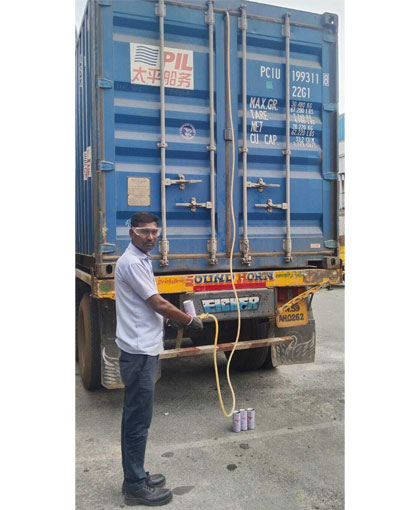Cargo Fumigation
Cargo fumigation refers to the process of treating goods or shipping containers with fumigants (chemical gases or vapors) to eliminate pests, such as insects, rodents, or other harmful organisms, that could potentially be carried with the cargo. The fumigation ensures that the goods meet the phytosanitary (plant health) regulations required by many countries before they are transported internationally or domestically.

Here's an overview of cargo fumigation:
1. Why Cargo Fumigation is Needed
- Prevent Spread of Pests: Certain pests, like wood-boring insects, beetles, or weevils, can travel with cargo and invade other countries, causing damage to local environments and industries.
- Regulatory Compliance: Many countries have strict regulations regarding the entry of cargo to ensure that it is pest-free. Fumigation ensures compliance with the standards set by authorities like the International Plant Protection Convention (IPPC) and World Trade Organization (WTO).
- Protecting Agriculture: Some pests can damage crops and food products. Fumigating agricultural products and packaging materials before shipment helps prevent pest-related losses.
2. Types of Cargo That Typically Require Fumigation
- Wood Products: Wooden pallets, crates, and packing materials are prime carriers of pests like termites and other wood-boring insects.
- Grains and Food Products: These can attract pests such as insects or rodents, which can spoil the product or affect its quality during transport.
- Seeds and Plants:Plants and seeds, especially those intended for export, may carry pests that could harm agricultural areas in other countries.
- Machinery or Equipment: These items may contain pests, especially in crevices or hidden areas that are difficult to inspect.
- Phosphine (PH3): One of the most commonly used fumigants for cargo. It is used to treat bulk grains, dried fruits, and other dry products.
- Methyl Bromide (CH3Br): Previously widely used, though its use is being phased out in many countries due to environmental concerns. It is highly effective against wood-boring insects and other pests.
- Sulfuryl Fluoride (SF): Often used for fumigating packaged goods and containers, especially for pests like termites and beetles. Carbon Dioxide (CO2): Sometimes used for cargo fumigation, especially in environments where the use of chemicals is restricted or less desirable.
- International Standards: The International Plant Protection Convention (IPPC), part of the Food and Agriculture Organization (FAO), sets the standards for pest control in international trade. They provide guidelines for the treatment of wooden packaging and other commodities.
- Phytosanitary Certificates: Many countries require that goods, especially agricultural products, be accompanied by a phytosanitary certificate that confirms they have been fumigated and are free of pests.
- Fumigation Certificates: A fumigation certificate is often provided by pest control companies as proof that the cargo has been treated according to the required regulations.
- Wood Packaging and Pallets: The ISPM 15 standard (International Standards for Phytosanitary Measures No. 15) applies to wooden packaging materials, including pallets, crates, and boxes. This standard requires that all wooden packaging used in international shipping be treated, often by fumigation, to eliminate pests.
- Agricultural Commodities: Fumigation of foodstuffs, grains, and seeds helps ensure that they are free from pests like weevils, beetles, and rodents before shipment.
- Personal Effects and Household Goods: If shipping household goods or personal effects internationally, fumigation might be required to prevent pests like bedbugs or rodents from being transported.
- Toxicity of Fumigants: Fumigants like phosphine and methyl bromide are toxic to humans and animals, so it's essential that fumigation is conducted by professionals who are trained in handling these chemicals.
- Ventilation: Proper ventilation is necessary after fumigation to remove any residual fumigant and make the area safe for handling the cargo.
- Regulatory Compliance: Cargo fumigation must follow the guidelines of the destination country to avoid delays or fines. Non-compliance can result in the cargo being rejected or returned.
- Experience and Certification: Choose a service provider that is experienced and certified to perform fumigation according to international standards.
- Compliance with Regulations: Ensure that the company is familiar with the fumigation requirements of the destination country and can provide the necessary certificates.
- Inspection and Documentation: A reputable fumigation service provider will conduct a thorough inspection of the cargo and provide proper documentation to certify that fumigation has been completed.
- Cargo fumigation is an essential part of global trade to ensure pest-free movement of goods. It helps safeguard ecosystems, agriculture, and industries across the world by preventing the spread of harmful pests.
